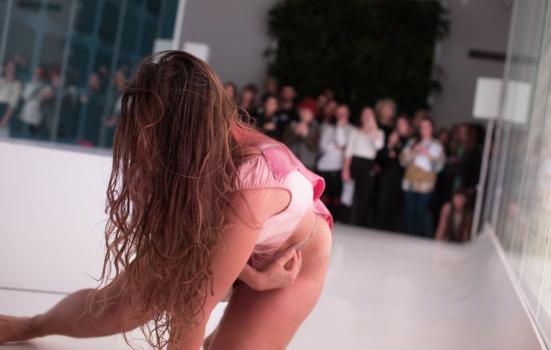Grace Nicol wants to redefine how we make dance to support more risky work. The answer, she thinks, lies in greater pastoral care.

Mario Bertieri
I am currently working on a collaborative dance project tackling themes of bodily autonomy in the context of dance, fashion and public spaces like museums and galleries. Together with fashion designer Sinead O’Dwyer, dance artists Alethia Antonia, Dorna Ashory, Iro Costello, Florence Pearl and Natifah White, we are using the project, Slip Mould Slippery to explore practices for working together in the studio and what it now means to make performance for public venues. Through R&D studio time, we are questioning the autonomy of the performer, the power dynamics of inviting people to be seen, and where power and responsibility lie within these exchanges.
An offer of care
The project is being supported by a new pastoral care offer which I have developed in partnership with dance artist Temitope Ajose-Cutting. We are attempting to redefine the way choreographers work with freelance dance artists by better supporting the wellbeing and needs of dancers both inside and outside of the work. Our aim is to challenge the common experience of a freelancer. Freelancers are often picked up and dropped into disparate processes with little if any through-line between the different projects. These processes pay little regard to the dancer’s needs and experiences beyond the confines of the project.
Our offer of care is not generic; rather it is tailored to the specific needs and requests of the dancer. Throughout the project, the dancers paid to attend mentoring sessions with Temitope in which a range of issues are explored: things within the project that need addressing, how this project fits into their wider career goals, their relationships outside dance, the impact of lockdown, and so on. In addition to mentoring, the dancers are provided with training in other pastoral related issues. I have built ‘open-conversation’ time into the start of the choreographic sessions and given the dancers direct access to Sinead, our designer, and producer Treacle Holasz.
Natifah, one of our collaborating artists, said this process has been really helpful for her: “Temi is really good at allowing me to talk about how this project specifically feeds or informs – or potentially contests – my other engagements. She is also really curious about how the project is going.” For Natifah, understanding that the sessions are confidential and that this is a safe space is important.
Non-traditional relationships
The pandemic and global movements like Black Lives Matter have thrown the need for additional care in artforms that deal with the live body into sharp relief. We believe that this is not only important for dancers’ wellbeing but provides performers with more support, allowing the flexibility for deeper work to occur. The key to this is tackling the very real lack of stability and structure that freelance artists often face. Having an experienced and empathetic practitioner with whom the dancers can identify – someone who is dedicated to that role and not the producer or choreographer – is paramount. There is a sense of levelling out that comes with this way of working, which opposes traditional hierarchical choreographer-performer relationships.
We are also working in galleries and museums; spaces often unfamiliar with programming dance and understanding dancers’ needs. In these contexts, there may be little time for negotiation and only limited capacity for programmers and producers to supply this level of care. Temitope’s role offers an additional level of advocacy in such spaces which sometimes have problematic institutional practices or damaging traditions for performers. It also provides a means of reminding venues about their shared responsibility within these frameworks. Ultimately, it’s about all stakeholders – producers, curators, choreographers and dancers – taking equal responsibility for each other in negotiating a shared environment.
Advocating for artists
We hope this project will contribute to dance by providing examples of how care can be introduced into working practices. Our research has included online zoom sessions, hosted by me and Dance4, with gallery programmers and artists across the UK, to gain insight into what is needed when programming/making dance in this context. This has been disseminated as part of a free, interactive public dance pack. The pack identifies challenges around programming and suggests solutions for artists and venues. It will also include findings from working with these methods. The interactive digital pack is freely available to stakeholders through the Dance4 website from March 25 as part of their Talking Thinking Dancing seminar series.
We see this project as advocacy. Hopefully, it will develop the provision of pastoral care for other freelance artists, initially through the online information pack. We hope our work encourages dance companies to apply the strategies and practices we have tested to their projects and non-conventional performance spaces and to adopt our approach.
Grace Nicol is an Associate Artist at Dance Research Studio.




